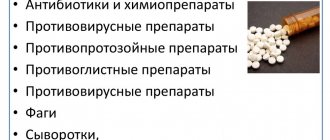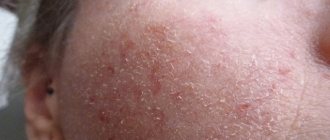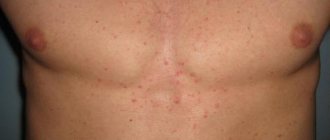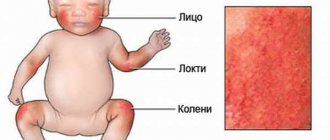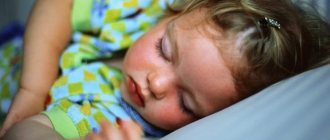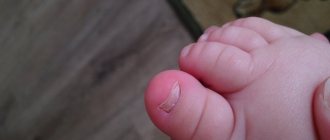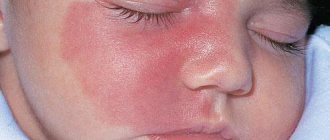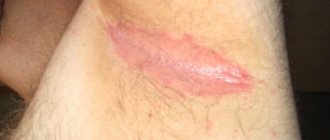Photo: Allergic rash
Poor nutrition
A red rash on a child’s bottom, as well as on the face and near the mouth, may appear when the body has an allergic reaction to certain foods.
Very often, such signs occur when introducing a new diet or artificial feeding.
Products at risk include the following:
- tomatoes;
citrus;
Typically, allergic reactions appear in children under one year of age and are eliminated by eliminating the product that caused the unpleasant symptoms.
If the child is breastfed, then the mother should very carefully introduce new foods, with an interval of no more than 3-5 days.
The rash can appear if the baby is in diapers for a long time, which causes redness and diaper rash.
Therefore, it is important to carefully ensure that the child at least sometimes ventilates the skin and is bare-bottomed.
Also, a certain brand of diapers can cause an allergic reaction or irritation, in which case they must be replaced immediately.
Photo: Reaction to diaper
Washing powder
Modern hygiene products often contain many irritating substances.
To wash children's clothes, use a special hypoallergenic powder.
But even a mild product can cause rashes on sensitive skin, so consult your doctor.
If a child stays in a room with high humidity and high temperature for a long time, this can cause a red rash to appear all over the body.
Because of this, the child becomes irritable and lethargic.
A rash can also appear due to the presence in the child’s body of allergens to dust and pollen, which often flies in through open windows in the summer.
To eliminate irritants, you should:
- carry out wet cleaning more often;
- ventilate the premises;
- Do not keep many flowering plants at home that attract insects.
Determining the type of rash will help make an accurate diagnosis and prescribe the correct treatment.
When diagnosing, we start from:
- location of the rash;
- her colors;
- intensity;
- size of spots.
A red rash on a child's bottom can indicate several diseases. Infants sometimes suffer from toxic erythema, which occurs in the first weeks of life. The disease is not dangerous and usually goes away on its own.
Neonatal pustulosis is another cause of a severe red rash on the butt and other parts of the body.
It can last quite a long time, up to three months, but does not pose any particular danger to the baby.
If this type of rash has small peeling scales, then this indicates allergic reactions during breastfeeding and to food.
Symptoms are eliminated by avoiding the allergenic product or using weak antihistamines.
Important! The most serious and dangerous red rash is considered to be the one caused by viral infections.
This:
- scarlet fever;
- rubella;
- chicken pox.
Such diseases require immediate treatment under the supervision of a specialist. With the right treatment, symptoms disappear within a few days.
Photo: Red rash
White rash
Rashes of this type appear under the influence of many factors.
The most common cause is an allergic reaction, and the baby experiences:
- runny nose;
- lacrimation;
- slight swelling of the face.
The cause of a white rash on a child’s bottom can be viral and infectious diseases, during which the following occurs:
- temperature increase;
- itching;
- peeling of the irritated area.
Important! If such symptoms appear, you should contact a dermatologist or therapist as soon as possible.
A small rash with a white head is common in newborns. Rashes can affect not only the butt, but also the body and even the baby’s face.
This is due to the fact that the newborn’s body adapts to new environmental conditions. As a rule, such a rash goes away on its own and does not require intensive treatment.
Photo: White rash
Hemorrhagic rash
The hemorrhagic rash localized on the buttocks and legs of children deserves special attention. This disease affects patients aged 3 years and older.
The presence of such a rash indicates a serious disease called hemorrhagic vasculitis.
There are many factors that cause this disease:
- intensive medication use;
- suffered stress;
- presence of allergens;
- weak immunity;
- hypothermia.
Important! A characteristic sign of a hemorrhagic rash is the absence of changes in the shape and color of the rash when pressed.
Red spots appear as a result of damage to the capillaries, as some red blood cells leave the vessel.
If you suspect such rashes, you should immediately call a doctor. Treatment of vasculitis is necessary only in a hospital setting.
Photo: Hemorrhagic vasculitis
Can a child be allergic to red?
Allergy-causing foods are indeed red. However, an allergy to them may not be related to color at all. The human immune system has a special memory at the genetic level. That is why very often childhood allergies occur when the body does not accept allergens that are unusual and uncharacteristic for the region where the family lives.
What does it mean? If a child is offered an exotic fruit or vegetable, then the child is more likely to show signs of an allergy, while products familiar to the region will not cause any consequences. An allergy is an individual reaction of the body to an external irritant, which is largely associated not with the color of the product, but with its components.
Skin allergy remedies for children
Skin allergy ointment for children is a dosage form that is a homogeneous mixture of base and active substance. The ointment base itself does not provide a therapeutic effect. If the active and auxiliary components are soluble in the base, then the ointment is called homogeneous. If they are insoluble, then the ointment takes the form of a suspension, paste or cream.
Homogeneous ointments penetrate deeper into the skin better, that is, they are effective for chronic diseases (especially if there are painful subcutaneous lumps). If there are acute inflammations, in which the permeability of the skin is increased, then a children's cream for skin allergies is preferable.
Non-hormonal ointments and creams for skin allergies
Such remedies are successfully used even in the treatment of infants. They extremely rarely have side effects.
Fenistil is a gel that has anesthetic properties, effectively relieves irritation and soothes itching. It is used for various insect bites, burns (including sunburn), dermatosis, eczema, and urticaria. It can be used to treat babies older than 1 month.
If inflammation or bleeding occurs in the area of the rash, then it is better to avoid this remedy. Skin areas treated with Fenistil should not come into contact with sunlight.
Another effective remedy for skin allergies for children and adults is Skin-Cap. Effective in both gel and cream form. It has an antibacterial effect and is successfully used for dry skin, psoriasis, seborrheic and atopic dermatitis.
Bepanten is a skin allergy cream for children and adults that heals affected areas. It will eliminate dryness and improve skin regeneration. They treat dermatitis, skin damage and irritation. It is even suitable for caring for the delicate skin of newborns, as it eliminates dryness and irritation well.
Elidel can be used if the child is older than 3 months. It has an anti-inflammatory effect and is most often used for severe dermatitis and eczema. This allergy cream can have a number of side effects, including irritation, redness and itching, so it should be used carefully.
Hormonal ointments and creams for skin allergies
Skin allergies in children are treated with such drugs only in situations where other medications do not give the desired effect. Hormonal drugs are extremely effective, but their use carries the risk of suppressing adrenal function.
Elokom is an ointment with pronounced anti-inflammatory properties. It is used to treat dermatitis, dermatosis and eczema in children over 2 years of age. It is not recommended to use it on large affected areas of skin.
Advantan cream and ointment are used to treat eczema, dermatitis and neurodermatitis in children who have reached the age of 6 months. Quickly suppress inflammatory reactions, relieve itching and pain.
Lorinden, Flucinar, and hydrocortisone ointment are also prescribed, but they are characterized by high absorption, as well as systemic effects, that is, they are unsafe for the immune system. In the case of treating children, such a risk is unacceptable.
Manifestations of food allergies in a child
| Organ | Symptoms |
| Airways | Rhinitis, frequent sneezing, nasal congestion, dry cough, wheezing, laryngeal edema, Quincke's edema |
| Leather | Hives, red spots, rash, itching, flushing, peeling, crusting |
| Gastrointestinal tract | Constipation, diarrhea, vomiting, swelling of lips and tongue |
| System | Hypotension, bronchial obstruction, abdominal pain, angioedema |
The most common red food that children are allergic to is tomatoes. A reaction to tomatoes occurs in many people, since the vegetable is one of the most allergenic. Tomato contains about 20 different components that can cause an acute reaction in the body. If a child has a reaction to tomatoes, then most likely he may also have an increased sensitivity to potatoes or eggplants.
If we consider berries, the first place among allergens is occupied by the beloved sweet strawberry. Often the child's reaction to strawberries, the color of which is known to be red, misleads young mothers into believing that the child is immune to all red foods. A strawberry allergy occurs as a reaction to salicylic acid and protein. Allergenic products containing the same substances may also be intolerable to the child’s body, and their color will not necessarily be reddish.
Clinical picture
There are no specific manifestations of allergies to any particular drug. Allergy should not be confused with overdose due to improper use of drugs. Various parts of the child’s body can be affected by an allergic reaction.
Most often, in response to the drug entering the body, the immune system reacts with skin manifestations in the form of rashes. They can be in the form:
- spots;
- papules;
- vesicle;
- urticulum;
- erythema;
- erosions.
An allergic rash in children is usually accompanied by severe skin itching and burning, pain in the inflamed areas. Temperature often rises, sleep is disturbed, and arthralgia develops. The liver and kidneys may be affected.
Characteristics from the central nervous system:
- anxiety;
- irritability;
- depression.
The respiratory organs react to medications with shortness of breath, wheezing, whistling, bronchospasm, and attacks of suffocation. The mucous membranes of the nose and eyes react with swelling and redness. Swelling of the mucous and soft tissues of the oropharynx is very dangerous. Quincke's edema develops, in which the child loses the ability to breathe.
If the vascular system is involved in the inflammatory process, hemorrhagic vasculitis develops, in which vascular tone decreases and blood circulation deteriorates. With inflammation of blood vessels and swelling of the skin, anaphylactic shock develops, which is very dangerous for the child’s life.
Allergy Symptoms – Do you know what an allergy to red foods looks like?
Allergies to red-tinged foods can manifest themselves symptomatically in the same way as allergies to flowers or any other irritant. Types of allergies can be very different and affect different organs and vital systems of the child, for example, the gastrointestinal tract, respiratory tract, skin, etc.
It is difficult to say how long it takes for an allergy to manifest itself and how to identify the irritant product - for some, the reaction occurs immediately, while for others only a few hours after the last meal. How long it takes for the allergy to go away also depends on the child’s personal characteristics and the treatment measures taken by the parents.
Signs of allergies
An allergic reaction may occur in different parts of the body. It can be observed from several minutes to several days.
- Diarrhea, upset stomach, vomiting
- Hay fever, asthma
- Eczema, urticaria
- Joint pain and inflammation
- Sore, red, watery eyes Complications
- Acute vascular insufficiency
- Anaphylactic shock
- Rapid pulse
- Cold sweat
- Sticky skin
- Stomach cramps
- Hives
- Difficulty, wheezing
- Convulsions
- Dizziness
- Nausea
If medical attention is not given promptly, severe allergies can lead to death.
Allergies in children under one year of age may manifest themselves as the following:
- The appearance of a red rash on the skin, which is usually concentrated in certain areas of the body, often on the face and in the folds of the skin;
- Skin allergies can manifest as dry crusts on the scalp. Red spots cause discomfort in the baby, they itch and itch;
- Allergic urticaria in the form of a rash on the cheeks, arms and other parts of the body;
- Facial allergies may also be accompanied by swollen lips, and allergic rashes usually affect the cheeks and chin;
- Allergies, the manifestations of which often also occur in the eyes, can result in conjunctivitis, lacrimation, hyperemia of the eye membranes;
- Nasal congestion due to allergies occurs due to swelling of the mucous membranes, which can also provoke allergic rhinitis and frequent sneezing;
- Allergic swelling in the throat is manifested by a severe cough, shortness of breath, and difficulty breathing. An allergic cough can also trigger angioedema, in which the child experiences life-threatening asthma attacks;
- Acute allergic reactions may also include attacks of nausea, vomiting, dizziness, diarrhea, constipation and anaphylactic shock.
Symptoms
An allergic reaction to a baby’s bottom is often accompanied by similar manifestations in other places, for example, legs, cheeks, scalp, etc. A symptom of such a disease can be a rash or spots of various shapes, colors and sizes. The rashes themselves are divided into the following types: vesicle, papule, erythema.
Such manifestations are usually associated with the direct allergen. Unpleasant symptoms disappear as soon as the child’s body stops contacting it.
Some mothers confuse an allergic reaction to the butt with regular diaper rash, which occurs as a result of frequent contact with wet diapers or wet diapers.
Naturally, with diaper rash, the rash will be localized only in places in contact with a moist environment. Please note that after hygiene procedures, traces of diaper rash disappear without a trace. An allergic rash does not go away until you find the harmful allergen and get rid of it.
The following reasons cause an acute reaction of the child’s body:
- Individual intolerance to any specific product;
- The presence of an allergen substance in the product in the case of red products is the natural pigments anthocyanin and lycopene;
- Exotic fruits can also cause some types of allergies;
- GMO;
- Fruits and vegetables high in nitrates;
- The child does not have enough enzymes that are necessary to digest reddish-colored foods;
- Excessive consumption of red fruits and vegetables provokes an inadequate reaction in a fragile child’s body.
Causes of the disease
There is a large list of products that are known allergens. But for children of different age groups, the diet differs in composition. For this reason, food allergies that occur in children under one year old, from 1–7 years old and schoolchildren (7–18 years old) differ in the set of products - allergens.
- Food allergies in children under one year of age most often appear (in descending order) to cow's milk, eggs, fish, wheat, citrus fruits, and legumes. Some of them lose their antigenicity during heat treatment (cow's milk proteins), and some do not (fish, eggs).
In children under one year of age, a phenomenon called cross-allergy is possible. For example, if you are allergic to the components of cow's milk, sensitization (hypersensitivity) to beef or the milk of other animals may develop. Therefore, the tradition of giving a child goat’s milk to reduce his allergy symptoms has no justification.
- In preschool children, the diet is expanding, and sensitization manifests itself in the form of allergies to cereal products, fruits, vegetables, and dairy products. At the same time, very often hypersensitivity to cow's milk, eggs, and some legumes that existed before the age of one year may disappear by the age of 4–5 years.
At this age, sensitization to apples can cause cross food allergies to birch and alder pollen; to grapes - for quinoa pollen. If you are intolerant to mushrooms, you develop a food allergy to cheeses, dairy products, yeast dough, etc.
- In school-age children, sources of food allergies include milk, eggs, peanuts, nuts, soybeans, fish and crustaceans, and wheat.
How to treat allergies in a child?
It is important to remember that the treatment of allergies and their symptoms can only be determined by an allergist, who must be visited if a reaction to products occurs. The doctor will be able to accurately identify which foods and substances cause an acute reaction in the child’s body and prescribe the appropriate medication. An allergist will tell you how to quickly relieve a child’s allergies if he accidentally ate an allergenic product, and will also recommend a healthy diet for the baby.
A diet for allergies should completely exclude from the diet everything that was identified as a result of an allergy test and skin tests. Nutrition for allergies during an exacerbation should include a large amount of water, as well as taking enterosorbents that remove toxins. Ancillary preparations such as nasal and eye drops, anti-inflammatory and antimicrobial ointments, antiemetics, enzymes to improve the functioning of the gastrointestinal tract, etc. will help alleviate the manifestations and symptoms of allergies.
Treatment
Typically, the main goal of an allergist providing treatment is to eliminate allergens that have arisen in the baby’s body. If this fails, then the number one task becomes reducing the intensity of exposure to allergenic substances.
Parents must find an allergen in their apartment that provokes negative consequences.
There are also allergies to food. In this case, the diet of the child or mother (if the baby is breastfed) is reviewed. For such moments, there is a hypoallergenic diet developed by specialists, which to some extent helps to alleviate the condition of the little patient and speeds up treatment.
Local therapy
Local therapy for allergic reactions to a baby’s bottom may involve the use of special ointments, antihistamines, medicated creams and treatment of the affected areas with green stuff.
Allergic rashes adjacent to diaper rash are sometimes aggravated by the addition of a bacterial infection. The rash in such cases spreads to other areas. Most often it can be observed not only on the butt, but also on the legs. Treatment in such cases is carried out with antibiotics or antibacterial drugs.
The prevention of such problems is to frequently treat the baby’s back and bottom with special antiseptic decoctions or medical solutions when changing diapers.
Changing diapers regularly is key to preventing problems with rashes and allergies.
Drugs
In addition, there is treatment for various manifestations of allergies using tablet medications, which are prescribed by a pediatrician or allergist if necessary. Among the drugs most often used are drugs such as tavegil, claritin, suprastin, cetrin and the well-known diphenhydramine.
But everyone knows that it is difficult for a small child to take pills because they have to be divided into pieces. It is sometimes difficult for parents to measure the required dose of a tablet drug for a small child.
Therefore, do not forget that only a professional doctor can develop an optimal treatment regimen for your baby. Moreover, the medications themselves can provoke side effects.
Parents, in order to avoid worsening the baby’s condition, should not forget to regularly ventilate the children’s room, put screens on the windows to protect against insects, carry out daily wet cleaning and remove flowering plants from their home.
Diet
Nursing mothers who have discovered that their child has an allergy to the buttocks need to accustom themselves to regularly keeping a food diary, where the entire daily diet is recorded. In addition, new products can be added to the menu no more than once a week.
After which observation of the baby’s reaction is required. This is done both in the case of breastfeeding and when the child feeds himself. If you follow these rules, it will be very easy to determine the food cause of allergic rashes.
Allergenic foods that doctors advise you to avoid completely:
- Cocoa;
- Coffee;
- Strawberry;
- Chocolate;
- Citrus;
- Confectionery;
- Smoked meats;
- Honey;
- Mushrooms;
- Nuts;
- Fatty fish.
The consumption of these products should be limited, as they are potential allergens:
- Pumpkin;
- Eggs;
- Milk;
- Starchy vegetables;
- Bread;
- Bakery;
- Pasta;
- Bananas;
- Red apples;
- Tomatoes;
- Carrot.
Traditional methods
Allergies to a child's bottom can be treated using traditional methods. However, when using the power of medicinal herbs, you should be careful, since an overdose of substances contained in the proposed decoctions can lead to undesirable consequences.
Most often, for the normal condition of the skin and its complete cleansing, a decoction of chamomile and string is used. It helps not only with allergies that appear on the skin, as it contains soothing and healing substances.
Also among folk recipes you can find nettle infusion , which is used to wipe rash-affected areas of the skin. A decoction of oak bark and calendula has beneficial properties , which is used to treat the skin on the butt, thereby reducing the number of rashes.
All these folk recipes are good, however, self-medication can be dangerous for your child.
If allergies occur, it is best to seek qualified help from a pediatrician. The baby’s body is very sensitive, and the use of various drugs may not alleviate the condition, but only cause harm.

